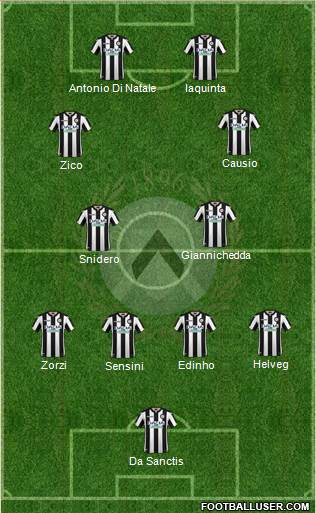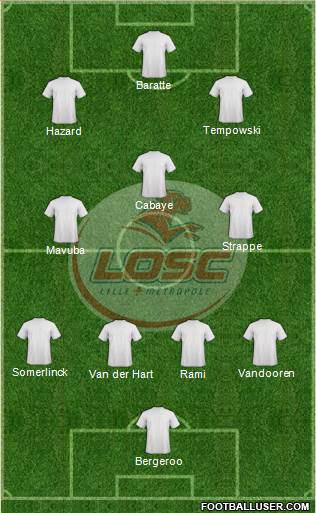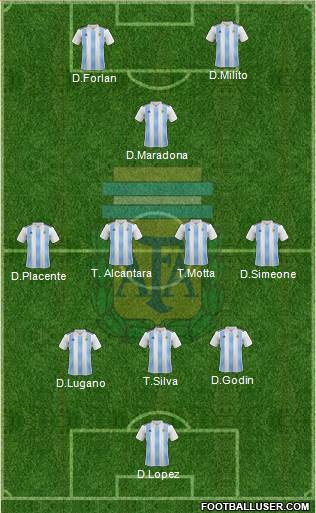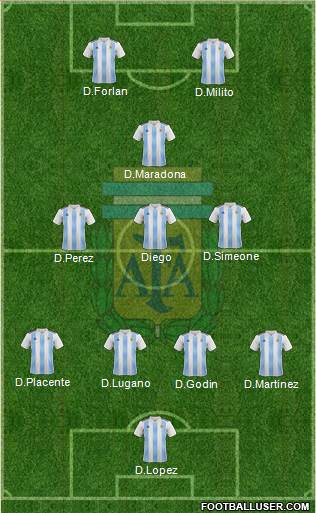 |
| Mitropa Cup winner 1980 |
AC Milan, Juventus, Inter Milan,
Roma, Lazio, Torino, Napoli, Fiorentina,
Sampdoria, Geona, Bologna, Parma, Udinese, Brescia.
This is my selection of a 25 member all-time team for the club. The number 25 was chosen because it is the official squad size for the Champions' League.
Udinese Calcio, commonly referred to as Udinese, is an Italian football club based in Udine, Friuli-Venezia Giulia, that currently plays in Serie A. It was founded on 30 November 1896 as a sports club, and on 5 July 1911 as a football club.
The traditional team home kit is black and white striped shirt, black shorts, and white socks. They are sometimes called "The Little Zebras" based on their black and white striped shirts. The club broadcasts on channel 110 (Udinese Channel) on digital terrestrial television in north-east of Italy. It has many fans in Friuli and the surrounding areas.
 |
| 2000 UEFA Intertoto Cup |
GK: Morgan Da Sanctis (Italy)
Morgan Da Sanctis is brilliant keeper, but his international opportunities limited by playing at the same time as Gianluigi Buffon. He only had 6 caps. He was, however, included in squads for Euro 2008, the 2010 FIFA World Cup and Euro 2012. From 1999 to 2007, he played for Udinese. Then, he had another long career with Napoli.
GK: Samir Handanović (Slovenia)
From 2004, Samir Handanović was capped over 70 times for Slovenia. He went to the World Cup Finals in 2010. For club football, he was best remembered as a top keeper in Serie A. He was voted the best keeper for 2013 in Italy. He is one of only three non-Italian keepers to be named Serie A Goalkeeper of the Year, winning the honor twice. He is nicknamed Batman due to his acrobatic saves.
GK: Luigi Turci (Italy)
Turci started his career at native club Cremonese, helping the team promoted to Serie A in 1993. After Cremonese were relegated to Serie B in 1996, he joined Udinese. He moved again in 2002, this time to U.C. Sampdoria. In 2005, he joined Cesena in Serie B for whom he played 62 league games before hanging up his boots in 2007.
RB: Thomas Helveg (Denmark)
The most prominent period of his career was his five years with AC Milan, with whom he won the 1999 Serie A championship and 2003 UEFA Champions League tournament. He was named 1994 Danish Player of the Year. He has participated in the 1996, 2000 and 2004 European Championship and the 1998 and 2002 FIFA World Cup tournaments. He also played for Udinese, Inter Milan, Norwich City and Borussia Mönchengladbach.
 |
| Thomas Helveg |
Bertotto started his professional career during the 1990–91 season with Alessandria. He joined Udinese in 1993, spending thirteen seasons there, also captaining his side to what is to date their only appearance in the UEFA Champions League, and also becoming the Udinese player with the highest number of matches ever played for the team. He later played for Siena and Venezia. He was capped 4 times.
CB: Edinho (Brazil)
Born in 1955, Edinho played 45 times for Brazil. He went to three World Cup Finals: 1978, 1982 and 1986. He was the captain of the 1986 team. Edinho was also in the team which finished fourth at the 1976 Summer Olympics. He spent most of his career with Fluminense, but also played with Flamengo and Fluminense FC. In Europe, he played with Udinese in Italy and Gremio.
CB: Per Krøldrup (Denmark)
Krøldrup started his footballing career at Danish lower league club Aalborg Chang. He went on to play for B 93 Copenhagen before transferring to Udinese in 2001. He played an successful season with Everton before spending 6 seasons with Fiorentina. Then, he played for Pescara and Olhanense. He was capped 33 times. He went to the 2004 European Championship.
CB: Alessandro Calori (Italy)
Calori was a product of Arezzo's youth system. He made his debut in 1985 with Serie C team Montevarchi. In 1991 Calori joined Udinese, where he spent eight seasons. In 1999 Calori, then aged 33, signed for Perugia, and gained space in the headlines as he scored the winning goal in a 1–0 win to Juventus in the final league week, a goal that unexpectedly let Juventus lose the Serie A title to Lazio.
CB: Roberto Sensini (Argentina)
Started in 1986 for Newell's Old Boys before moving to Udinese. Sensini moved to Parma in 1993, winning two UEFA Cups, two Italian Cups, and the UEFA Super Cup. He would then have a brief stint with S.S. Lazio, winning the scudetto, the Italian Cup, the UEFA Super Cup, and the Supercoppa Italiana. He played in the World Cup 1990, 1994 and 1998. In the 1990 FIFA World Cup Final Sensini conceded the disputed penalty kick from which West Germany scored their winning goal.
 |
| Roberto Sensini |
RB/LB: Luigi Zorzi (Italy)
Known as "Zorzi I", he made his debut in 1935 with Bellotto Sport. In 1936, he joined Udinese with whom he made his debut as an attacker. He later converted into a fullback. In 1945, he joined AC Milan. He briefly served in the armed force during the War. He also played for Sampdoria between 1946 and 1949. From 1949 to 1956, he again played for Udinese.
LB: Marek Jankulovski (Czech Republic)
Marek Jankulovski's most notable achievements include winning the UEFA Champions League with A.C. Milan and being voted the 2007 Czech Footballer of the Year. He earned 77 caps for the Czech Republic, and represented them at three European Championships, the 2000 Olympics and the 2006 World Cup.
DM: Giuliano Giannichedda (Italy)
Giannichedda started his career with A.S. Sora Calcio 1907 in the fourth division. In 1995 summer, he moved straight to the Serie A with Udinese Calcio. In 2000, he won the UEFA Intertoto Cup.
Giannichedda played with S.S. Lazio from 2001 until 2005. He also played for Juventus. He stayed with them for the 2006–07 season. He earned 3 caps for Italy.
DM: Cirano Snidero (Italy)
Cirano Snidero was the son of Udinese team bus driver.e He made his debut with Udinese in the 1947-1948 season in the Serie B. He helped the club to reach Serie A for the first time in 1950. He was known for his partnership with Augusto Magli. He was voted in 2012 by the fans of the club as its greatest midfielders. He later played with Alessandria and Pordenone.
 |
| Cirano Snidero |
CM: Gökhan Inler (Switzerland)
İnler began his career with FC Basel and later joined FC Aarau and FC Zürich, winning the Swiss Super League in both of his seasons with the latter. After four seasons with Udinese in the Italian Serie A, he joined Napoli in 2011, where he twice won the Coppa Italia. From 2006 to 2016, he was capped 89 times. He served as the Swiss captain.
AM/CM: Giampiero Pinzi (Italy)
Pinzi began his career with Lazio in 1999. From 2000 to 2015, he played with Udinese. He spent a plan spells Chievo during those years. At the end of his career, he played again with them, and then with Padova and Brescia. With Italy, he won a bronze medal at the 2004 Summer Olympics. He also earned a single senior cap in 2005.
RW: Franco Causio (Italy)
Franco Causio capped 63 times. He was a part of the Azzurri at Euro 1980 and then, the World Cup in 1982. He played 11 years for Juventus between 1970 and 1981. During a highly successful period with the club, he won the scudetto six times, as well as winning a Coppa Italia, and an UEFA Cup. He also reached the European Cup final with Juventus during the 1972–73 season.
RM/RB: Martin Jørgensen (Denmark)
For Denmark, Jørgensen earned 102 caps. He is the only player that has represented Denmark at three World Cups. He has also played at two European Championship tournaments. He began his career at the local club IF Midtdjurs in 1994. From 1997 to 2004, he played for Udinese. From 2004 to 2010, he played with Fiorentina.
LW/AM: Zico (Brazil)
Zico was the best player in the world during the early 1980's. He came eighth in the FIFA Player of the Century grand jury vote. He went to three World Cup Finals, but probably best remembered for the 1982 tournament, where the team was known as the best ever tram that never won the World Cup. He won the Intercontinental Cup in 1981 with Flamengo, a team that was considered among the greatest ever. He later played with Udinese for 2 seasons.
 |
| Zico |
Fiore started out with Cosenza in 1992, but known for his career with Parma, where he won two the UEFA Cups. He later played with Lazio, Udinese, Padova, Chievo, Valencia, Fiorentina, Torino, Livorno, etc. He was capped 38 times for Italy between 2000 and 2004 in period when Italy had many great attacker midfielders. He played at Euro 2000 and 2004.
FW/RWF: Enzo Menegotti (Italy)
Enzo Menegotti started with Modena, where he played 153 times. He spent a season at Milan, before moving to Udinese in 1952. He was the captain of the team that came second in Serie A behind Milan. He spent two seasons with AS Roma before returning to Udinese in 1959. For Italy, he made his national debut against West Germany in 1955. He played one more time that year. He was the first player to represent Udinese on the national team.
FW: Antonio Di Natale (Italy)
Antonio Di Natale is considered to be Udinese greatest player. He played 5 seasons with Empoli before siging with Udinese in 2004, where his career took off. He was the Seria A top scorer for two seasons: 2010 and 2011. At the international level, he only played 42 times for Italy. He was a key player at the World Cup Finals in 2010. He also went to the European Championship in both 2008 and 2012.
 |
| Antonio Di Natale |
Biefhoff scored the first golden goal in the history of major international football, for Germany in the Euro 96 final. The goal defined his career. He played 70 times for Germany between 1996 and 2002. He also played in Euro 2000, and both the 1998 and 2002 World Cups. He was a later bloomer. He was playing in Austria and Italy's Serie B until at the age 27 when he joined Udinese. He would later star for AC Milan.
ST: Lorenzo Bettini (Italy)
Bettini began his career with Brescia, debuting in Serie B in 1950. He played with AS Roma, Palermo and Lazio before making a name with Udinese where he had two stints. In 1954-1955 season, he finished as the second top scorer behind the Milan player Gunnar Nordahl. In 1961 he joined Helenio Herrera's Inter Milan, where he played a single season. He later played for Modena and Alessandria. He was capped 5 times for Italy B team.
 |
| Lorenzo Bettini |
At club level, Balbo played for Newell's Old Boys and River Plate before moving to Italy in 1989. In Italy, he played for Udinese, Roma (two stints), Parma and Fiorentina. He played four games for Boca Juniors before finally retiring. He scored a total of 138 goals in Serie A. For Argentina, Balbo earned 37 caps, and played at the 1990, the 1994, the 1998 World Cups, and the 1989 and 1995 Copas América.
ST: Vincenzo Iaquinta (Italy)
At the club lebel, Vincenzo Iaquinta made a name as the offensive partner of Antonio Di Natale while they played for Udinese. He also played for Juventus between 2007 and 2013. He played 40 matches for the Italy national football team between 2005 and 2010, scoring 6 goals. He was a part of Italy's World Cup winning team in 2006. He played in 5 out of 7 of Italy's matches in Germany.
 |
| Vincenzo Iaquinta |
Alexis Sánchez (Chile), Giampiero Pinzi (Italy), Danilo (Brazil), Paolo Poggi (Italy), Sulley Muntari (Ghana), Márcio Amoroso (Brazil), Roberto Muzzi (Italy), Dino Zoff (Italy), Arne Selmosson (Sweden), Bengt Lindskog (Sweden), David Pizarro (Chile), Simone Pepe (Italy) Armando Segato (Italy), Kurt Andersson (Sweden), Luigi De Agostini (Italy), Dino Galparoli (Italy), Mauricio Isla (Chile), Fabio Quagliarella (Italy).
Squad Explanation
-- Antonio Di Natale is probably Udinese's greatest ever player. He is their all-time leading scorer as well all-time appearance record holder.
-- Morgan De Sanctis' international career was limited by playing during Gianluigi Buffon's peak. Samir Handanović was Serie A Goalkeeper of the Year for 2010-2011 season.
-- Dino Zoff began his career here, but only spent a short time here. He helped to gain promotion to Serie A. I put him on honorable mention. Instead, I took Luigo Turci who had a longer career with Udinese. He also won the Intertoto Cup.
-- Rightback Valerio Bertotto captained Udinese to what is to date their only appearance in the UEFA Champions League. He was also the all-time appearance record holder for the club before Antonio Di Natale broke his record.
-- I first took Luigi Zorzi (Italy) who had a long career with Udinese for the leftback position. Then, I was choosing between Marek Jankulovski and Luigi De Agostini for the second leftback position. I took Jankulovski because he had a better international career. Dino Galparoli was also considered for the leftback position. He had a long career with the club.
-- Zico is probably the most well-known footballer ever played for the club. He was named Serie A Player of the Year in 1984. He finished second top-scorer for the same season with a single goal behind Michel Platini who played in more games. Unfortunately, his second season was marked by injuries. He left after two seasons. His performance in his first season put him as one of Udinese's greatest players.
-- Zico and Franco Causio were teammates with Udinese while Vincenzo Iaquinta and Antonio Di Natale formed a famous partnership up front.
-- Stefano Fiore earned his first Italian cap while playing for Udinese. David Pizarro, Roberto Sensini and Thomas Helveg also earned their first with their respective countries while playing for them.
-- With Zico and Stefano Fiore on the team, I do not need David Pizarro, Bengt Lindskog and Arne Selmosson. Instead, I selected four central/defensive midfielders Giampiero Pinzi, Gökhan Inler, Cirano Snidero and Giuliano Giannichedda. Cirano Snidero was voted as Udinese's greatest midfielder. Gökhan Inler (Switzerland) had a stronger international reputation than the other candidates.
-- Giampiero Pinzi is the third all-time appearance record leader. Besides playing the centre midfielder, he also could play in an advanced position. He was paired with Antonio Di Natale.
-- Enzo Menegotti was the first player from the club to play for Italy. I gave him credit for the milestone by selecting him.
-- Oliver Bierhoff was Serie A top scorer in 1996-1997 season for Udinese.
-- Alexis Sanchez was a star player here, but I have Antonio Di Natale, Lorenzo Bettini, Vincenzo Iaquinta and Abel Balbo ahead of him. Antonio Di Natale and Vincenzo Iaquinta are icons of the club while Balbo was Serie B top scorer while playing here. Alexis only scored 20 goals for the club. So he only made honorable mention.
-- Udinese came second in the 1955-1956 Serie A season. It was their highest ever finish. Lorenzo Bettini was a hero of that season.
-- Fabio Quagliarella also only made honorable mention because I have the other players ahead of him in his position.
Formation























